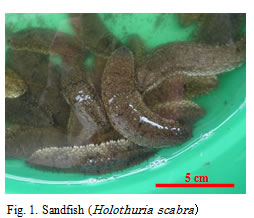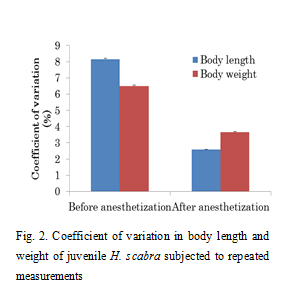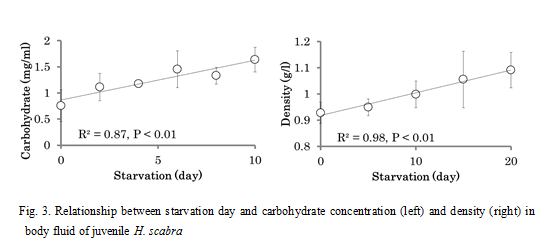Size measurement and nutritional condition evaluation methods in sandfish (Holothuria scabraJaeger )
Description
Over 60 species of sea cucumbers are fished commercially and traded in Southeast Asian and Pacific countries, and great demand for these sea cucumbers has caused severe overfishing in these countries. Depletion of natural stocks with high commercial value has encouraged hatchery production, stock enhancement and aquaculture programs of sea cucumbers, especially sandfish, Holothuria scabra (Fig. 1), the most valued of tropical sea cucumbers.
High mortality and slow growth are problems in H. scabra hatcheries, and rearing techniques must be improved for stable mass production of the seeds. However, there is one fundamental methodological problem: there are no standard methods for size measurement and for evaluating nutritional condition of sea cucumbers including H. scabra. Without correct determination of size and nutritional condition, evaluation and improvement of technologies are difficult. The aims of this study, therefore, were to establish accurate size measurement and nutritional condition evaluation methods for H. scabra.
Anaesthetization is reported to improve size measurement accuracy in Japanese common sea cucumber, Apostichopus japonicas. Although 0.5% KCl and 0.05% MgSO4 did not induce anesthesia, 2% - 4% menthol-ethanol in filtered seawater for 20 - 30 min was found effective and harmless. The anesthetization significantly reduced the coefficient of variation of the mean body length and weight in repeated measurements by 68% and 43%, respectively (Fig. 2).
During starvation, body size and weight decreased concomitantly, resulting in unchanged condition factor (body weight / volume), suggesting that condition factor cannot be used as an index of nutritional condition unlike in animals with axial skeletons or exoskeletons. Protein, cholesterol and carbohydrate concentrations in the body fluid (i.e. coelomic fluid and vascular fluid) were also analyzed to study the relationship with starvation. Since the protein and cholesterol concentrations initially increased and then decreased during starvation period, it is difficult to use them as indices of nutritional condition. The carbohydrate concentration showed a gradual two-fold increase during 10-day starvation (Fig. 3, left). Body fluid density (Fig. 3, right) and volume relative to body size gradually increased and decreased, respectively during 20-day starvation. High correlation coefficients indicate that these factors may be used as proxies for nutritional condition.
The aforementioned methods may be used to correctly monitor the conditions of H. scabra in studies for improving aquaculture and stock enhancement techniques. However, further physiological studies to elucidate the mechanisms behind the observed tendencies must be conducted.
Figure, table
- Affiliation
-
Japan International Research Center for Agricultural Sciences Fisheries Division
- Classification
-
Administration B
- Research project
- Program name
- Term of research
-
FY 2011 (FY 2011-FY 2016)
- Responsible researcher
-
Watanabe Satoshi ( Fisheries Division )
KAKEN Researcher No.: 40371877Zarate J. M. ( Southeast Asian Fisheries Development Center )
Sumbing Joemel Gentelizo ( Southeast Asian Fisheries Development Center )
Lebata-Ramos Ma. J. H. ( Southeast Asian Fisheries Development Center )
Nievales M. F. ( University of the Philippines Los Baños )
- ほか
- Publication, etc.
-
Watanabe et al. (2012) Aquaculture Research 43(6):940-948
- Japanese PDF
-
2011_17_A4_ja.pdf106.72 KB
- English PDF
-
2011_17_A4_en.pdf178.8 KB



